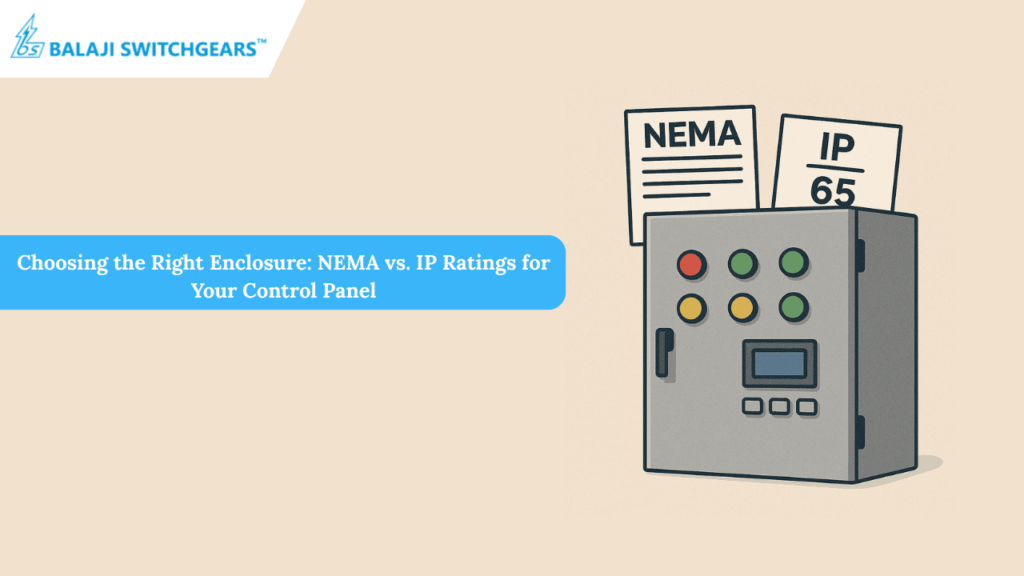Selecting the right enclosure for your electrical control panel is critical for ensuring system safety, longevity, and compliance with environmental conditions. Whether you’re designing an indoor automation system or an outdoor electrical distribution board, the enclosure must offer appropriate protection against dust, moisture, corrosion, and mechanical damage.
Globally, enclosure ratings are guided by two major standards: NEMA (used in North America) and IP ratings (used internationally). Both systems classify the protective qualities of an electrical panel enclosure, but they differ in scope and testing methods.
This blog explains how to understand and compare these two systems so you can make informed choices based on your environment.
1. Why Enclosure Ratings Matter
Enclosure ratings define the level of protection a control panel has against environmental hazards such as:
- Solid particles (dust, dirt)
- Water and moisture
- Corrosive substances
- Accidental contact
Choosing the correct rating helps avoid system failure, electrical hazards, and downtime—especially in industrial or outdoor settings.
2. Understanding NEMA Ratings (North American)
NEMA (National Electrical Manufacturers Association) defines enclosure ratings commonly used in the U.S. and Canada. These ratings cover protection from environmental conditions as well as corrosion resistance and construction strength.
Here are commonly used NEMA ratings for electrical panels, along with their protection level and usage:
| NEMA Rating | Protection Description | Common Use Cases |
| 1 | Indoor use; protects against limited dust and contact with live parts | Offices, clean mechanical rooms |
| 3R | Outdoor use; protects against rain, sleet, and external ice formation | Meter boxes, outdoor lighting panels |
| 4 | Indoor/outdoor; protects against windblown dust and water (hose-directed) | Industrial settings, wash-down areas |
| 4X | Same as NEMA 4, but adds corrosion resistance | Food processing units, coastal areas |
| 12 | Indoor use; protects against dust, falling dirt, and dripping non-corrosive liquids | Manufacturing floors, workshops |
| 13 | Indoor use; protects against dust, sprayed water, oil, and coolants | Machine shops, lubricated systems |
A NEMA 1 electrical control panel enclosure is suitable for dry indoor locations, such as server rooms or office control stations.
A NEMA 4X enclosure is the best choice for environments exposed to wash-downs or chemical vapors.
Always select based on environmental exposure, not just cost or availability.
3. Understanding IP Ratings (International)
IP ratings (Ingress Protection) are defined under IEC 60529 standards and used worldwide. The IP format is written as IPXY, where:
- X = protection against solids (0–6 scale)
- Y = protection against liquids (0–9K scale)
Examples:
- IP54: Dust-protected and water splashing resistance
- IP66: Total protection against dust and strong water jets
- IP67: Dust-tight and immersion-proof
These ratings focus specifically on ingress from particles and liquids and are often used in Europe, Asia, and global exports.
4. Comparing NEMA vs. IP Ratings (Corrected as per Fibox USA)
While NEMA and IP ratings are based on different test procedures, the following table shows generally accepted equivalents:
| NEMA Type | Approx. IP Equivalent | Protection Summary |
| 1 | IP10 | Indoor; limited dust and accidental contact protection |
| 3R | IP14 | Outdoor; protects against falling rain and sleet but not against windblown dust |
| 4 | IP66 | Indoor/outdoor; protection from hose-directed water and total production from dust |
| 4X | IP66 + corrosion resistance | Same as NEMA 4 with added protection against corrosion (e.g., stainless steel or polycarbonate) |
| 12 | IP52 | Indoor; protects from dust, falling dirt, and dripping non-corrosive fluids |
| 13 | IP54 | Indoor; protects from dust, oil, water spray, and non-corrosive coolants |
📌 Note: These are approximate equivalents. Since NEMA tests for corrosion, icing, and construction integrity, some ratings (like 4X and 13) may exceed what IP ratings measure.
5. How to Choose the Right Enclosure
When choosing between NEMA and IP for your electrical control panel, consider:
- Location: Indoor vs. outdoor
- Exposure: Water, dust, chemicals, or oil
- Material: Metal vs. plastic, corrosion risk
- Compliance: Local or international standards
- Maintenance: Ease of cleaning and inspection
If your operations are in North America, follow NEMA guidelines. If you’re exporting equipment or working in global markets, IP ratings may be required.
Conclusion
The selection of the right enclosure is a crucial part of designing a durable, safe, and compliant control panel. Whether you choose NEMA-rated or IP-rated electrical panels, understanding the exact protection levels helps avoid costly failures and ensures long-term reliability.
At Balaji Switchgears, we provide enclosure solutions tailored to your operational needs, whether it’s a compact indoor electrical panel or a rugged industrial control panel for harsh environments. We ensure every project meets the right rating standards—so your systems stay protected, efficient, and future-ready.

